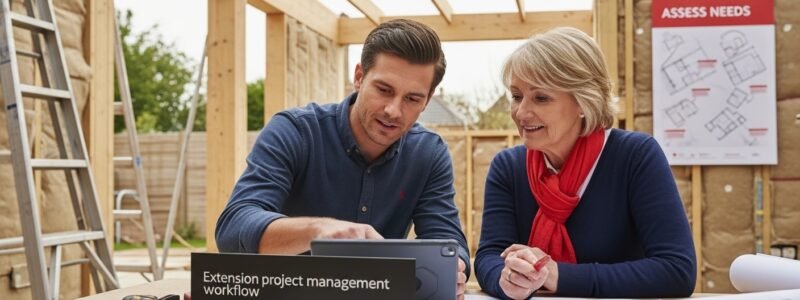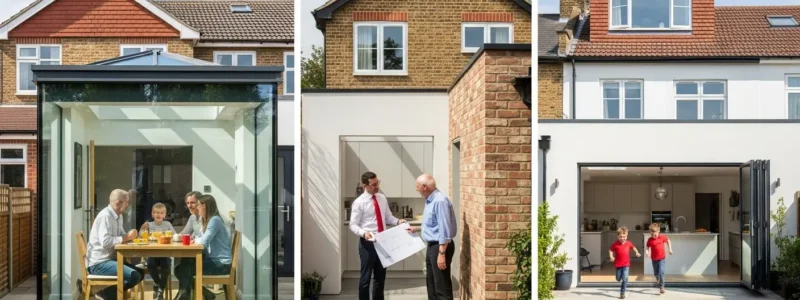Home extensions in London are attracting more attention than ever, especially as families chase more space without packing up and moving. That is no surprise with single-storey extensions now costing between £3,300 and £3,500 per square metre according to official building guidelines. Most people assume the biggest challenge is finding enough time or money for such a project. Yet the real surprise is just how much your location and even tiny design tweaks can inflate your bill faster than you ever expected.
Table of Contents
- What Is A Home Extension And Why Consider One?
- Factors Influencing Home Extension Costs
- Key Components Of Home Extension Budgeting
- Understanding Planning Permissions And Regulations
- Real-World Examples Of Home Extension Costs In London
Quick Summary
| Takeaway | Explanation |
|---|---|
| Home extensions enhance property value | Increasing living space through extensions typically raises market value and can offer financial returns on investment. |
| Plan for structural complexity and costs | The extent and design complexity of your extension significantly affect budgeting and planning requirements. |
| Understand planning permissions | Familiarise yourself with permitted development rights to avoid delays and ensure compliance with local regulations. |
| Account for indirect costs in budgeting | Consider expenses like regulatory fees and site preparation, which can make up a substantial part of your overall budget. |
| Consult professionals for seamless execution | Engaging experienced architects and builders can ease the extension process and help avoid unforeseen challenges. |
What is a Home Extension and Why Consider One?
A home extension represents a strategic property improvement project that allows homeowners to expand their existing living space without relocating. Essentially, it involves constructing additional rooms or areas attached to the original dwelling, transforming the property’s layout and functionality. Home extensions in Islington have become increasingly popular as families seek to maximize their property’s potential.
Understanding Home Extension Fundamentals
Home extensions offer homeowners a flexible solution to accommodate growing family needs, enhance property value, and create bespoke living environments. According to UK government planning guidance, these improvements can range from modest rear extensions to comprehensive multi-storey additions.
Key motivations for considering a home extension include:
- Creating additional living space without moving
- Increasing property market value
- Avoiding expensive relocation costs
- Personalizing living environments to match specific family requirements
Practical Considerations for Home Extensions
Successful home extensions require careful planning and consideration of multiple factors. Homeowners must evaluate structural feasibility, budget constraints, planning permissions, and the potential impact on existing property layout. The goal is to design an extension that seamlessly integrates with the original building while meeting functional and aesthetic objectives.
Whether you are looking to add a kitchen, create a home office, or expand your living areas, a well-executed home extension can dramatically transform your property’s utility and appeal. Professional guidance from experienced extension specialists ensures a smooth, compliant, and cost-effective project that aligns with your specific residential requirements.
Factors Influencing Home Extension Costs
Home extension costs represent a complex interplay of multiple variables that determine the financial investment required for transforming your living space. Understanding these factors helps homeowners make informed decisions and develop realistic budgetary expectations for their property improvement projects.
The following table organises the main factors that influence home extension costs, helping you to quickly compare their impact and nature.
| Factor | Description | Typical Impact on Cost |
|---|---|---|
| Geographical Location | Regional labour, material rates, and regulations. | High |
| Total Square Meterage | Overall floor space added to the property. | Directly proportional |
| Construction Materials | Standard versus premium quality materials used. | Moderate to high |
| Architectural Complexity | Design intricacy, number of storeys, and structural needs. | High |
| Site-Specific Challenges | Foundation, ground conditions, proximity to other structures. | Variable, often significant |
| Professional Service Rates | Fees for architects, builders, and engineers, especially in urban areas. | Moderate to high |
| Interior Finishes | Specification and quality of final fit and fixtures. | Moderate |
Core Cost Determinants
The total expense of a home extension depends on several interconnected elements. According to research from the UK government’s housing metrics, key factors encompass geographical location, construction complexity, and specific project requirements.
Primary cost influencers include:
- Total square meterage of the proposed extension
- Quality and type of construction materials
- Complexity of architectural design
- Site-specific structural challenges
- Local labour and professional service rates
Structural and Design Complexity
Architectural complexity significantly impacts extension costs. Simple, rectangular single-storey extensions typically cost less compared to intricate designs featuring irregular shapes, multiple levels, or sophisticated structural modifications. Factors like foundation requirements, roof design, and integration with existing property can substantially increase overall project expenses.
Considerations such as ground conditions, proximity to existing structures, and potential need for specialized engineering solutions will directly influence the financial investment. Homeowners should anticipate potential additional costs for structural reinforcements, drainage modifications, or site preparation work.
Material and Labour Cost Variations
Construction material selection plays a crucial role in determining extension expenses. High-end materials like premium hardwoods, specialized glass, or custom-manufactured components will escalate costs compared to standard building materials. Similarly, labour rates vary across different regions, with urban areas like London experiencing higher professional service charges.
Careful planning, comprehensive professional consultation, and detailed project scoping can help manage potential cost variations and ensure a more predictable financial outcome for your home extension project.
Key Components of Home Extension Budgeting
Home extension budgeting demands meticulous financial planning and comprehensive understanding of potential expenses. By breaking down budgetary components, homeowners can develop realistic financial strategies that encompass both anticipated and unexpected project costs.
The table below breaks down the key cost categories for home extensions, offering clear distinctions between direct and indirect expenses commonly encountered.
| Cost Category | Description | Typical Proportion of Budget |
|---|---|---|
| Direct Costs | Materials, labour, architect/design fees, and equipment rental. | 60-70% |
| Indirect Costs | Permissions, regulatory compliance, site prep, waste removal, and potential temporary housing. | 15-25% |
| Structural Modifications | Expenses relating to reinforcing or altering property structure or foundations. | Variable |
| Permit/Regulatory Fees | Planning permissions, building control and compliance charges. | Variable |
| Contingency | Buffer for unforeseen expenses or design adjustments. | 10-15% |
Initial Budget Framework
Creating a robust budget begins with establishing a clear financial foundation. According to UK government cost estimating guidance, developing a transparent and detailed budget requires systematic assessment of multiple financial elements.
Critical budget components include:
- Material procurement costs
- Labour and professional service fees
- Structural modification expenses
- Permit and regulatory compliance charges
- Contingency fund allocation
Comprehensive Cost Categories
Direct costs represent the most transparent financial aspects of home extension projects. These encompass tangible expenses like construction materials, professional labour, architectural design fees, and specialized equipment rentals. Homeowners should anticipate that direct costs typically constitute approximately 60-70% of the total project budget.
Indirect costs include less visible but equally important financial considerations such as planning permissions, building regulation compliance, site preparation, waste removal, and potential temporary accommodation expenses during construction. These supplementary costs can represent 15-25% of the overall project investment.

Strategic Financial Planning
Successful home extension budgeting requires a strategic approach that balances comprehensive planning with financial flexibility. Establishing a contingency fund of 10-15% above the estimated project cost provides essential financial buffer against unexpected challenges or design modifications.
Careful documentation, regular cost tracking, and consultation with professional extension specialists can help homeowners maintain financial control throughout the project lifecycle. By understanding and anticipating potential financial variables, individuals can transform their home extension vision into a financially manageable reality.

Understanding Planning Permissions and Regulations
Planning permissions represent a critical legal framework governing home extension projects, ensuring that property modifications comply with local and national building standards. Navigating these regulations requires homeowners to understand the intricate balance between individual property rights and broader community development guidelines.
Permitted Development Rights
According to UK government planning guidance, homeowners can undertake certain extensions without formal planning permission under permitted development rights. These rights provide flexibility while maintaining essential regulatory oversight.
Key characteristics of permitted development include:
- Specific size and height restrictions
- Limited coverage of original property footprint
- Constraints on proximity to property boundaries
- Restrictions on building materials and design
- Requirements for maintaining architectural harmony
Scenarios Requiring Full Planning Permission
Full planning permission becomes mandatory when proposed extensions exceed permitted development limitations. Complex scenarios necessitating comprehensive approval typically involve:
- Extensions significantly altering property’s external appearance
- Projects in conservation areas or listed buildings
- Proposals exceeding prescribed dimensional limits
- Developments potentially impacting neighbourhood characteristics
Regulatory Compliance Strategies
Successful navigation of planning regulations demands proactive engagement with local authorities. Homeowners should conduct thorough research, prepare detailed documentation, and potentially consult professional architectural services to ensure complete compliance.
Careful consideration of local planning policies, consultation with municipal planning departments, and comprehensive project documentation can streamline the permissions process. By understanding and respecting these regulatory frameworks, homeowners can transform their extension vision into a legally compliant and structurally sound reality.
This table summarises the types of planning requirements for home extensions, clarifying when full planning permission is required versus when permitted development rights may apply.
| Planning Scenario | Permission Requirement | Typical Triggers |
|---|---|---|
| Permitted Development | Not required (if within limits) | Smaller size/height, maintains original property appearance |
| Full Planning Permission | Mandatory | Exceeds limits, alters external appearance, conservation area |
| Permitted Development (with constraints) | May require prior notice | Near boundaries, specific material/design constraints |
| Conservation Area/Listed Building | Always required | Extensions affecting historical or protected properties |
Real-world Examples of Home Extension Costs in London
Home extension costs in London represent a nuanced financial landscape influenced by multiple interconnected factors. Understanding realistic pricing requires comprehensive analysis of actual project scenarios across different London boroughs and property types.
Single-Storey Extension Pricing
According to London Borough of Redbridge building guidelines, single-storey extensions demonstrate significant price variation. Typical cost ranges for standard single-storey extensions span between £3,300 to £3,500 per square metre, with final expenses determined by specific project characteristics.
Factors influencing single-storey extension costs include:
- Complexity of architectural design
- Quality of construction materials
- Site-specific structural requirements
- Interior finishing specifications
- Professional service and labour rates
Two-Storey and Multi-Level Extension Examples
Two-storey extensions represent more complex and financially substantial home improvement projects. Pricing typically ranges from £3,500 to £3,700 per square metre, reflecting increased structural complexity and additional building regulations compliance requirements.
Additional cost considerations for multi-level extensions encompass:
- Enhanced structural engineering requirements
- More intricate planning permission processes
- Higher material transportation and labour expenses
- Advanced thermal and acoustic insulation needs
- Potential utility system modifications
Location-Specific Cost Variations
London’s diverse borough landscape creates significant price fluctuations. Western and central London areas like Kensington, Chelsea, and Westminster typically experience higher extension costs compared to outer boroughs. Factors such as property age, local building regulations, and neighbourhood architectural standards substantially influence overall project expenses.
Homeowners should approach home extension budgeting with flexibility, anticipating potential additional expenses and maintaining a comprehensive contingency fund to manage unexpected project requirements.
The following table presents typical cost ranges for different types of home extensions in London, as discussed in the article.
| Extension Type | Typical Cost Per Square Metre | Main Factors Affecting Cost |
|---|---|---|
| Single-Storey | £3,300 – £3,500 | Materials, design complexity, site requirements, finishes |
| Two-Storey/Multi-Level | £3,500 – £3,700 | Structural engineering, permissions, insulation, utilities |
Take the Uncertainty out of Your Home Extension Costs
If you are feeling uncertain about how much a home extension could actually cost, you are not alone. The article highlights how complex variables, budgeting surprises, and intricate planning permissions can cause stress and confusion. Many London homeowners worry about hidden expenses, unclear designs, and losing control of the process. These concerns can make what should be an exciting improvement project feel overwhelming.
Now is the time to take control of your plans and put your mind at ease. With over 20 years of expertise, our team at Reltic Extend specialises in delivering precisely the type of transparent service described in the article. We offer clear stage-by-stage pricing, help with every planning permission challenge, and handle complete project management so you get a seamless experience from start to finish. Ready to turn your dream extension into a reality without budget shocks? Discover your potential project costs with our cost calculator and see how we approach custom solutions by reaching out through our Contact Page. Take the step today at https://relticextend.co.uk/contact-us/ and speak directly to specialists who know how to deliver legally compliant, stylish, and durable home extensions in London and Surrey.
Frequently Asked Questions
What factors influence the cost of a home extension?
The cost of a home extension is influenced by factors such as the total square meterage, quality of materials used, architectural complexity, structural challenges, and local labour rates.
How should I budget for a home extension project?
Budgeting for a home extension requires a clear framework, considering both direct costs like materials and labour as well as indirect costs such as planning permissions and compliance fees. It’s advisable to allocate a contingency fund of 10-15% for unexpected expenses.
Do I need planning permission for my home extension?
You may not need planning permission if your extension falls within permitted development rights, which have specific size and height restrictions. However, exceeding these limits or making significant alterations usually requires full planning permission.
What are the common costs associated with a single-storey extension?
Typical costs for single-storey extensions range between £3,300 to £3,500 per square metre. Factors such as design complexity, material quality, and site-specific requirements will affect the final cost.
Recommended
- Home Extensions Islington | Builders Islington | Reltic Extend
- Archiwa home extension budget – Reltic Extend
- Archiwa extension costs London – Reltic Extend
- Archiwa Cost-Effective Building – Reltic Extend
- How Removals Quotes Are Calculated in the UK: 2025 Guide | Schott Removals





